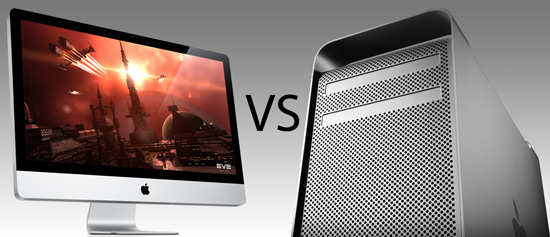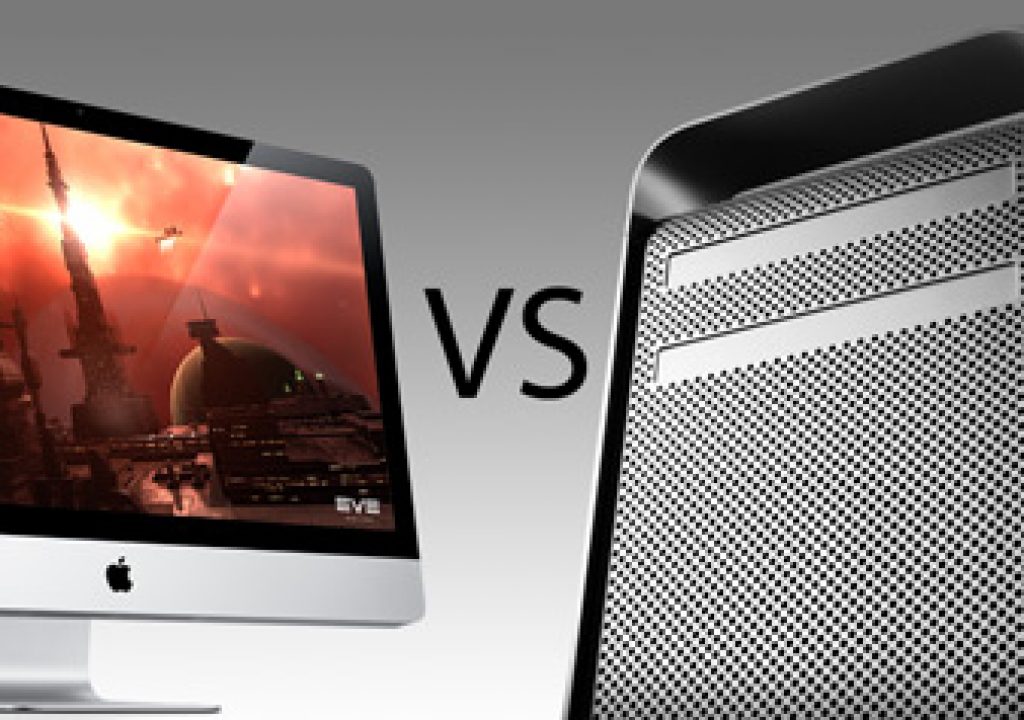
New Quad core Macs: high end iMac or low end Mac Pro?
Apple today announced new Mac Pros (coming sometime in August) and new iMacs (available now). Both have available Quad Core (4 processor) models. The iMac has a built in screen which the Mac Pro lacks, but the tower has scads of easy expandability. Which to buy?
Read on for the deets and analysis.
What you’d get for how much:
iMac:
27″ 2560×1440 display
2.8GHz Quad Core i5 and Turbo Boost, 8MB L3 cache, yes Turbo Boost but NOT Hyper-Threading
4GB RAM, 4 slots for up to 16GB of RAM
1TB drive
ATI Radeon HD 5750 w/1GB GDDR5 SDRAM
NO PCIe slots
NO additional internal drive bays
keyboard, mouse, etc.
(AppleCare is $169 if you want it)
Total price: $1999
Mac Pro:
gotta buy a display, so how about Apple’s new 27″, 2560×1440, $999 model?
2.8 GHz Quad Core Intel Xeon W3530 Nehalem with HyperThreading and Turbo Boost
UNKNOWN amount of RAM – current systems ship with 3GB of RAM, bet they’ll bump to 4GB
4 memory slots for up to 16GB of RAM
UNKNOWN amount of HD – current systems ship with a 640GB, bet they’ll bump to 1TB
ATI HD 5770 w/1GB GDDR5 SDRAM – two MiniDisplayPorts, one dual link DVI
3 empty internal drive bays – just slot in a drive
3 PCIe slots
keyboard, mouse, etc.
(currently AppleCare is $249 if you want it)
Total Cost: Estimated at least $3500
Price differential: at least $1500 for an Apples to Apples comparison – that is a 75% price increase. So first off, if you are on a budget, this one may be solved for you already. But maybe not, depending on what you want to do with it and how much you’ll want to grow your system.
How would I realistically configure these? I’d go 2.93 Hyper-Threading for the iMac, 2TB of storage for both, and 8GB RAM. Then the prices are and for the iMac and $2550 and $4100 for the tower – still about $1500 difference roughly. Toss in Final Cut Studio 3 if you don’t have it, and it is $3550 vs $5100. Now you’re talking about only a 43% bump up, not 75%.
But if you already have a monitor, that price differential is smaller – now you’re looking at $2550 vs $3100 without FCS, and a single vs dual monitor setup.
What do you get for your money?
CPU
-faster processor – yes, they are both 2.8GHz, but look closer – the Xeons are faster at a given clock speed, plus you get Hyper-Threading which the base iMac Quad Core doesn’t offer. And I’d bet that even with the slight clock speed advantage, the memory bus is likely faster on the Mac Pro (no bus speed listed for the iMac), and yadda yadda I’d bet a new Mac that the Mac Pro is faster for anything we’d be doing with it.
GPU
-slightly better GPU – only a slight edge – here’s the tech specs on the two models
Radeon HD 5770 (model used in the Mac Pro)
-800 Stream Processors
-850MHz Core Clock
-1GB GDDR5
-1.2GHz Memoy Clock
Radeon HD 5750 (model used in the iMac)
-720 Stream Processors
-700 MHz Core Clock
1GB GDDR5
-1150MHz Memory Clock
….so probably not a huge difference there – hotwardware.com gave the 5770 an 8-20% edge in game performance.
Up until this point, just looking at CPU/GPU, not a very compelling difference. But here’s where the potential advantages start to show.
Expandability
And here’s where the pros leave the wannabes behind. If you want to interface with a professional display or deck, you’re going to need SDI or more likely HD-SDI. And the only affordable way to do it is with a PCIe card. The iMacs don’t have any PCIe expansion at all, and the towers offer 3 available slots – one x16 and two x4 (these numbers refer to how many lanes of PCIe traffic they can handle – more is faster).
Want a pro video interface? You can buy a $3500-$4000 AJA IO HD or KiPro, but then that kinda blows, pricewise, compared to a $300 Decklink card from BlackMagic Design if all you want is SDI/HD-SDI in and out that you can install and configure in 10 minutes. This no dig against the IO HD and KiPro – they rock for a ton of things – but if basic I/O is what you’re after, they are the only solution for iMacs. OOPS – wrong! The Motu V4HD does ProRes for about $2000 as well. But still…pricey for what you’re after. But they haven’t gained nearly as much support/mindshare in the market as AJA. I have no solid reason to not recommend it, but I also realize I haven’t heard peep from them or anyone about it in the last year or more – I hear about AJA’s stuff all the time. That isn’t a recommendation against, just a gut reaction. Anyway, the point is, if you’re ever going to need pro video I/O, especially for HD, that alone can nix the price savings of an iMac over a Mac Pro when it comes to the relative costs of adding it to the two different systems. And keep in mind that adding one of these systems limits you to ProRes – no uncompressed, and perhaps limited support for other formats via those devices as well.
If you need to add high speed storage beyond a simple RAID 0 or RAID 1, ya gotta do it via a PCIe card to get any serious performance. FW800 tops out at 80 MB/sec – a single SATA drive can exceed that nowadays. If you want data redundancy and protection, RAID 3 or better yet RAID 5 is the way to go, and again, PCIe is how you get there while also offering throughput above 80 MB/sec. Even a simple eSATA card can offer 225+ MB/sec with 2 or more drives attached in RAID 0. Want to attach to a SAN? Bare minimum you need two GigE ports, which the iMac has only one of, or more likely a fiber channel card.
Want to add a Red Rocket for accelerating conversion of Red footage? Gotta have a PCIe slot for that. Want a Kona3 or DeckLink card? Again, Mac Pro only.
You get the idea – a lot of professional needs are only solved by the Big Box.
Storage
Besides hooking up to RAIDs and SANs, the basics of storage are very limited on the iMac as compared to a Mac Pro. Starting simply, adding even one drive – on a Mac Pro, just buy a bare drive, spend 5 minutes with a screwdriver and you’re installed and rolling and it fits inside the case – no additional data or power cords lying around. On an iMac, you can add a USB drive (but don’t for editing!) or better yet a FW800 drive – now you’re daisy chaining externals. Externals cost more because they have to have an enclosure with power and data interfaces. Be sure to get one with passthrough ports, so you can daisychain the next drive. Got two little drives (like my 2.5″ drive based G-Tech and La Cie drive in front of me now) and you’re hosed – can’t connect them both unless you have a FireWire hub….which run at least $100 or $150.
Want a RAID? You can buy hardware RAIDs for FW800, but they won’t do any better than 80 MB/sec. Since single drives can exceed 110 MB/sec nowadays, frankly, that limitation really sucks. My G-Tech 4TB FW800 dual drive RAID costs about $500 online. Two 2TB drives can be bought online for about $300-$400 depending on the model. Using a simple software RAID 0, that’ll push around 180-200 MB/sec instead of 80. Getting the idea here?
And of course if you want RAID 5 level protection, you can buy FW800 hardware RAIDs, but of course those options are pricier than PCIe based ones.
Want some real speed? A $300 Sonnet E4P card will let you connect 4 drives directly, or 4 enclosures with up to 5 drives apiece – 20 drives. While you could RAID 0 all those together, if any one fails you lose it all – so RAID 3, 5, 30 or 50 makes sense quickly. Which again, for anything over 80 MB/sec, requires PCIe.
You get the idea.
Video Formats & Monitoring
Ever want to capture from or master to a video tape? If it isn’t a FireWire based format, you’re going to need that HD-SDI interface again. And deck control, which these cards also provide.
The professional standard for video monitoring these days is HD-SDI and SDI. Pretty much everything is going to be watched on a non-CRT device these days, so analog CRT support is less of a concern. But if you want true 24p display support (not just film’s 24.0 fps, even 23.976 without pulldown), HDMI ain’t gonna getcha there.
Again, KiPro, IO HD or Moto V4HD can get you there, but not with as many supported formats.
RAM
If strictly comparing quad core devices, the RAM situation is pretty much a draw – they have the same number of slots. But if you get an 8 core (or more) Mac Pro, then you get 8 slots. Smaller RAM chips are cheaper, so more/smaller costs less than fewer/bigger.
In General
If you’re going to do offline editing, an iMac is fine. A 4TB G-RAID (don’t forget to back it up elsewhere!) can hold:
-over 225 hours of 1080p ProResProxy – good enough to cut with and watchable for DVDs
-over 100 hours of ProResLT, WAY fine for offlining and making DVDs and watchables
-over 72 hours of 1080p regular ProRes
-nearly 50 hours of 1080p ProResHQ
-over 30 hours of 1080p ProRes4444
You can watch and show clients/directors/etc. footage on an HDMI display or a 2nd monitor – in September Apple’s new $1000 2560×1440 (quad 720p) monitor will ship, and it supports displaying at 1920×1080 as well as 1280×720. A great 2nd monitor.
But if you want to edit and finish and be serious about it? Then you need a tower.
Other points –
If you want/need to tote it around easily for client presos or working on site, an iMac is a LOT easier to lug around, and cheaper to ship as well.
If you have budget for an 8 (or more) core, you get more RAM slots. If you have a lot of rendering to do, such as H.264 exports, DVDs or Blu-rays to make, the rendering performance difference gets substantial. But then we’re talking about an entirely different price category!
Mike’s Executive Summary
Making it easier still – if you’re editing and doing non-critical deliverables not on high end tape formats, you can totally GET BY with an iMac. Most freelance pure editors I know working from home? An iMac is just fine. Just be patient when you’re rendering. If you’re trying to do finishing work or deliver to tape, you’re really challenged/can’t effectively do it.

